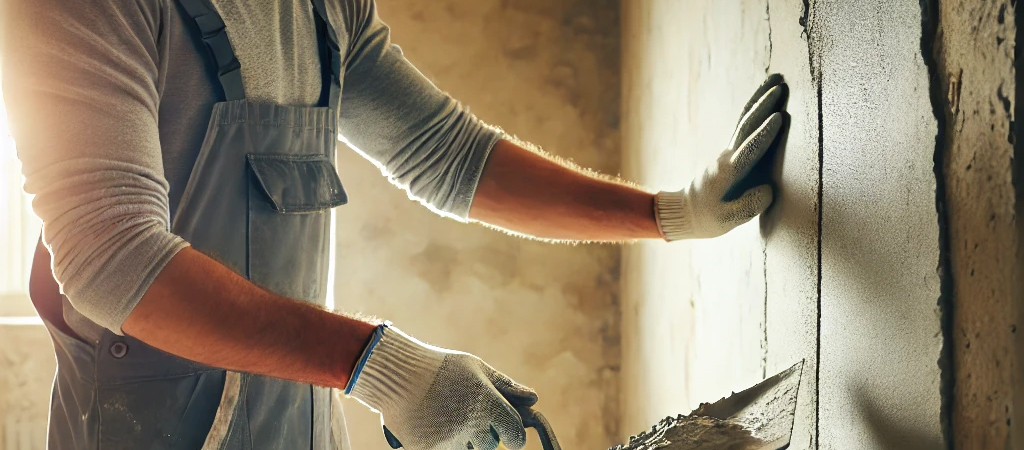How to Plaster a Wall
Detailed Guide on How to Plaster a Wall (UK)

Detailed Guide on How to Plaster a Wall (UK)
Plastering is a skill that can dramatically transform the look and feel of any room. Whether you’re renovating or doing some DIY, knowing how to plaster a wall properly ensures a smooth and professional finish. Below is a comprehensive step-by-step guide aimed at UK readers, including necessary preparation, plastering techniques, and post-plaster care.
Tools and Materials You’ll Need:
- Plastering trowel (ideally stainless steel)
- Mixing bucket and paddle or plaster mixer
- Plastering hawk (for holding plaster while you apply it)
- Corner trowel (for clean edges and corners)
- Plasterers float (for a smooth finish)
- Spirit level (for checking evenness)
- Bucket trowel (for mixing and applying plaster)
- Plastering brush (for finishing edges)
- Angle beads (to reinforce corners)
- Plasterboard or backing plaster (if needed)
- PVA (Polyvinyl Acetate) solution (for priming walls)
- Plaster (multifinish plaster is commonly used in the UK)
Step-by-Step Guide:
1. Preparation
Proper preparation is crucial for a smooth plastering job.
- Clean the wall: Remove old plaster, dust, or wallpaper remnants. Any grease, dirt, or moisture can prevent plaster from adhering.
- Fix imperfections: If there are cracks or holes in the wall, fill them with a suitable filler and let it dry.
- Protect surfaces: Cover floors, windows, and nearby fixtures with dust sheets or plastic coverings.
- Prime the wall: Use a PVA solution to seal the surface, ensuring good adhesion of the plaster. Mix PVA with water in a 1:4 ratio, and apply it evenly. Allow it to go tacky before plastering.
2. Mixing the Plaster
- Follow manufacturer instructions: Most plaster bags will include precise ratios of water to plaster.
- Add plaster to water: Never the other way around. Pour cold, clean water into the bucket and gradually sprinkle the plaster powder in, mixing it with a paddle mixer or manually with a bucket trowel.
- Mix until smooth: The plaster should have a thick, creamy consistency with no lumps.
- Rest the mixture: Let it sit for a couple of minutes before applying.
3. Applying the First Coat (Base Coat)
- Load the hawk and trowel: Use the bucket trowel to scoop plaster onto your hawk, then transfer it to your plastering trowel.
- Start from the corner: Begin applying plaster at the top corner of the wall, holding the trowel at a 10-15 degree angle.
- Work in small sections: Spread the plaster across the wall in upward strokes, working in small areas at a time.
- Aim for 2-3mm thickness: The first coat should be thin but even. Apply it consistently over the entire wall.
- Smooth and level: After covering the surface, use your trowel to smooth out any high spots or ridges.
4. Applying the Second Coat (Finish Coat)
- Wait for the first coat to set: This will usually take 15-30 minutes, depending on the room temperature and wall surface. The plaster should still be slightly damp but firm.
- Apply a thinner second coat: Repeat the plastering process, but this time aim for a thickness of about 1-2mm. This layer will help achieve a smooth, polished finish.
- Work quickly: Plaster can dry fast, so don’t take too long on any one section.
5. Finishing the Plaster
Once the second coat is applied, it’s time to smooth it out for a professional finish:
- Wait for the plaster to firm up: After about 20-30 minutes, the plaster will firm up enough to begin troweling for smoothness.
- Trowel off ridges: Use a clean, wet trowel to gently smooth out any ridges, starting from the top downwards.
- Polish the surface: Lightly spray the wall with water using a spray bottle, then use wide sweeping motions with your trowel to create a polished look.
- Work on edges and corners: Use a corner trowel or a small brush to refine the plaster around windows, doorframes, or edges.
6. Drying and Curing
- Allow time to dry: Plaster typically takes 2-3 days to fully dry, depending on room conditions.
- Do not paint immediately: Avoid painting or wallpapering for at least a week to let the plaster fully cure and prevent moisture buildup behind the surface.
- Check for cracks: Small cracks may appear as the plaster dries, but they can be easily filled before painting.
Common Tips for Plastering Success:
- Work in manageable sections: If you’re plastering a large wall, divide it into sections to avoid the plaster drying out before you’re done.
- Keep tools clean: Regularly clean your trowel, hawk, and bucket to prevent dried plaster from affecting your finish.
- Practice on small surfaces: If you’re new to plastering, try practicing on a small area or old plasterboard to get the feel for applying and smoothing.
Troubleshooting Common Issues
- Plaster drying too quickly: Ensure you’re working in a cool, well-ventilated room and don’t apply plaster too thickly.
- Uneven finish: Keep your trowel at a consistent angle, and don’t press too hard while smoothing.
- Cracks appearing: This can happen if the plaster dries too fast. To avoid this, ensure the wall is evenly prepared with PVA and try misting with water if drying is occurring too rapidly.
Conclusion
Plastering a wall takes patience and practice, but with the right tools, preparation, and techniques, you can achieve a smooth, professional finish. Make sure to take your time with each step, particularly in mixing the plaster and smoothing the final coat. Once mastered, plastering can save you significant money on home improvements while giving your walls a polished look.
This guide provides a clear path from preparation to finishing, so whether you’re a DIY enthusiast or a beginner, you’ll be ready to take on your plastering project with confidence!
-
Plasters
Thistle Multi Finish Plaster 25kg
Original price was: £10.80.£10.20Current price is: £10.20. inc vat -
Plasters
Gyproc Dri-Wall Adhesive 25kg
Original price was: £15.90.£14.60Current price is: £14.60. inc vat -
Plasters
Thistle Bonding Coat 25kg
Original price was: £14.50.£13.92Current price is: £13.92. inc vat -
Plasters
Thistle Board Finish Plaster 25kg
Original price was: £9.80.£9.60Current price is: £9.60. inc vat









